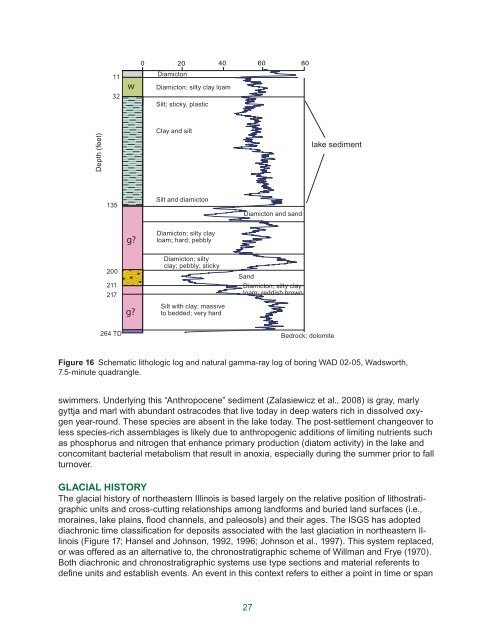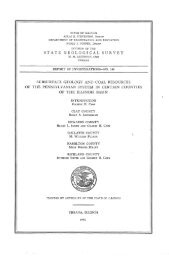Deglacial History and Paleoenvironments of Northeastern Illinois
Deglacial History and Paleoenvironments of Northeastern Illinois
Deglacial History and Paleoenvironments of Northeastern Illinois
- No tags were found...
You also want an ePaper? Increase the reach of your titles
YUMPU automatically turns print PDFs into web optimized ePapers that Google loves.
1132w020DiamictonDiamicton; silty clay loamSilt; sticky, plastic40 6080Depth (feet)Clay <strong>and</strong> siltlake sediment135Silt <strong>and</strong> diamictonDiamicton <strong>and</strong> s<strong>and</strong>g?Diamicton; silty clayloam; hard; pebbly200211217g?Diamicton; siltyclay; pebbly; stickySilt with clay; massiveto bedded; very hardS<strong>and</strong>Diamicton; silty clayloam; reddish brown264 TDBedrock; dolomiteFigure 16 Schematic lithologic log <strong>and</strong> natural gamma-ray log <strong>of</strong> boring WAD 02-05, Wadsworth,7.5-minute quadrangle.swimmers. Underlying this “Anthropocene” sediment (Zalasiewicz et al., 2008) is gray, marlygyttja <strong>and</strong> marl with abundant ostracodes that live today in deep waters rich in dissolved oxygenyear-round. These species are absent in the lake today. The post-settlement changeover toless species-rich assemblages is likely due to anthropogenic additions <strong>of</strong> limiting nutrients suchas phosphorus <strong>and</strong> nitrogen that enhance primary production (diatom activity) in the lake <strong>and</strong>concomitant bacterial metabolism that result in anoxia, especially during the summer prior to fallturnover.GLACIAL HISTORYThe glacial history <strong>of</strong> northeastern <strong>Illinois</strong> is based largely on the relative position <strong>of</strong> lithostratigraphicunits <strong>and</strong> cross-cutting relationships among l<strong>and</strong>forms <strong>and</strong> buried l<strong>and</strong> surfaces (i.e.,moraines, lake plains, flood channels, <strong>and</strong> paleosols) <strong>and</strong> their ages. The ISGS has adopteddiachronic time classification for deposits associated with the last glaciation in northeastern <strong>Illinois</strong>(Figure 17; Hansel <strong>and</strong> Johnson, 1992, 1996; Johnson et al., 1997). This system replaced,or was <strong>of</strong>fered as an alternative to, the chronostratigraphic scheme <strong>of</strong> Willman <strong>and</strong> Frye (1970).Both diachronic <strong>and</strong> chronostratigraphic systems use type sections <strong>and</strong> material referents todefine units <strong>and</strong> establish events. An event in this context refers to either a point in time or span27
















